Establishment and Verification of the Kinetics Model of Uranium Continuous Dissolution by Using Discrete Element Method
Abstract
:1. Introduction
2. Reaction Model Establishment and Parameter Setting
2.1. Discrete Element Method
2.2. Establishment of Reaction Kinetics
- when ε = εmax, φ1 = φ2,
- when ε = 100, φ2 = A2 + B2 + C2 = 0.
2.3. Physical Model
2.4. Simulated Operating Conditions
2.5. Reaction Model Verification
2.5.1. Comparison of Single Pellet Dissolution Experiments
2.5.2. Comparison of Continuous Dissolution Experiments
3. Results and Discussion
3.1. Pellet Dissolution Time
3.2. Changes in Nitric Acid Concentration and Uranium Concentration
4. Conclusions
- Based on the batch dissolution data of individual UO2 pellets, a kinetic model was developed to describe the dissolution reaction of these pellets. Subsequently, a dissolution reaction calculation program was created using the discrete element model to simulate the uranium dissolution process in a rotary drum dissolver.
- Due to the full mixed flow model and the assumption that the nitric acid concentration was uniformly distributed axially in the drum, the pellet dissolution rate in the experiment was higher than the simulation results, and the deviation between the simulation and the experiment was 10.8%. In the future, it will be necessary to consider the influence of the rotation of the drum and the countercurrent contact between the solids and liquids in the kinetic reaction model.
- When the dissolver reaches equilibrium, the pellets require 10 h to dissolve completely under standard operating conditions. The dissolver takes 30 h to reach the equilibrium. After 30 h, the uranium concentration in the dissolver is 243 gU/L and the concentration of nitric acid is 2.8 mol/L.
Author Contributions
Funding
Data Availability Statement
Conflicts of Interest
Nomenclature
| A1, B1 | correction factor parameter of the low percentage of dissolved volume |
| A2, B2, C2 | correction factor parameters of the high percentage of dissolved volume |
| Ci | stoichiometric number of each component of the solution |
| E1, E2 | reaction activation energy, J/mol |
| E1,ref, E2,ref | reaction activation energy at experimental temperature, J/mol |
| Fin,i | inlet flow rate of nitric acid, kg/s |
| Fout,i | outlet flow rate, kg/s |
| [HNO3] | concentration of nitric acid, mol/L |
| K1, K2 | pre-factor of reaction rate |
| Karea | initial surface area of pellets, m3 |
| M | total mass of solution, kg |
| Mi | mass of a certain solution component, kg |
| MWi | molar mass of each component of the solution, kg/kmol |
| R | reaction rate of pellets, kmol/s |
| S1 | stirring factor |
| T | reaction temperature, 300 K |
| Tref | experimental temperature, K |
| V | total volume of solution, 0.0215 m3 |
| Yi | mass fraction of the components of the solution in the dissolver, kg/kg |
| Yin,i | mass fraction of the components at the inlet of the nitric acid, kg/kg |
| αgas,max | maximum gas volume fraction on the solid surface without stirring, the value is 0.5 |
| αliquid | correction factor of solid–liquid contact area |
| Γ | order of reactant concentration |
| Ε | percentage of dissolved volume, % |
| εmax | percentage of dissolved volume at the maximum surface area of the pellet, % |
| Ρ | density, kg/m3 |
| Φ | reaction surface area correction factor |
| φ1 | correction factor for low percentage of dissolved volume |
| φ2 | correction factor for high percentage of dissolved volume |
| Ω | stirring speed, rpm |
| Subscripts | |
| I | subscript of solution component, HNO3, UO2(NO3)2, H2O |
References
- Cheng, Y.M.; Xia, S.; Liao, X.P.; Shi, B. Adsorptive Recovery of Uranium from Nuclear Fuel Industrial Wastewater by Titanium Loaded Collagen Fiber. Chin. J. Chem. Eng. 2011, 19, 592–597. [Google Scholar]
- Ye, G.A.; Jiang, Y.Q. Status and Development of Nuclear Fuel Reprocessing Technology in China. China Nucl. Ind. 2015, 012, 26–30. (In Chinese) [Google Scholar]
- Lu, W.H. Analysis of Spent Fuel Reprocessing Current Status in the World. Jiangxi Chem. Ind. 2018, 140, 16–18. (In Chinese) [Google Scholar] [CrossRef]
- Ye, G.A.; Zheng, W.F.; He, H.; Ma, J.; Wang, J. Status and Development of Technology on Reprocessing Spent Nuclear Fuel in China. At. Energy Sci. Technol. 2020, 54, 75–83. (In Chinese) [Google Scholar]
- Wu, Z.Q.; Qin, Y.Q.; Liu, Y.; Hou, Y.Y. Spent Fuel Batch Dissolver Enlarging Design and Hydraulics Experimental Investigation. At. Energy Sci. Technol. 2016, 50, 1480–1485. (In Chinese) [Google Scholar] [CrossRef]
- Gelatar, J.K.; Kumar, B.; Sampath, M.; Kumar, S.; Kamachi, U.; Natarajan, R. Dissolution of intact UO2 pellet in batch and rotary dissolver conditions. J. Radioanal. Nucl. Chem. 2015, 303, 1029–1035. [Google Scholar] [CrossRef]
- Jiang, S.J.; Ren, F.Y. Nuclear Fuel Reprocessing Engineering; Atomic Energy Press: Beijing, China, 1995; pp. 57–58. (In Chinese) [Google Scholar]
- Ren, F.Y.; Zhou, Z.X. Foreign Nuclear Fuel Reprocessing; Atomic Energy Press: Beijing, China, 2006; pp. 82–84. (In Chinese) [Google Scholar]
- Huang, Y.C.; Tang, J.; Xie, Q.R.; Ma, Y.F. Application of Computational Fluid Dynamics in Chemical Engineering. Mod. Chem. Ind. 2007, 27, 65–74. (In Chinese) [Google Scholar] [CrossRef]
- Hai, H.; Spencer, B.; Hales, J. Discrete element method for simulation of early-life thermal fracturing behavior in ceramic nuclear fuel pellets. Nucl. Eng. Des. 2014, 278, 515–528. [Google Scholar] [CrossRef]
- Sun, L.; Podila, K.; Chen, Q.; Bayomy, A.M.; Rao, Y.F. Computational Fluid Dynamics Modeling of Fire and Human Evacuation for Nuclear Applications. J. Nucl. Eng. Radiat. Sci. 2020, 6, 011112. [Google Scholar] [CrossRef]
- Wang, C.; Liu, H.; Wang, J.; Wu, Z.B.; Wang, L. Three-dimensional physical simulation experiment study on carbon dioxide and dissolver assisted horizontal well steam stimulation in super heavy oil reservoirs. J. Pet. Explor. Prod. Technol. 2016, 6, 825–834. [Google Scholar] [CrossRef] [Green Version]
- Li, Y.; Chen, R.; Guo, K.; Tian, W.X.; Qiu, S.Z.; Su, G.H. Numerical analysis of the dissolution of uranium dioxide by molten zircaloy using MPS method. Prog. Nucl. Energy 2017, 100, 1–10. [Google Scholar] [CrossRef]
- Bertolotto, S.; Szenknect, S.; Lalleman, S.; Magnaldo, A.; Raison, P.; Odorico, M.; Podor, R.; Claparede, L.; Dacheux, N. Effect of surface orientation on dissolution rate and surface dynamics of UO2 single crystals in nitric acid. Corros. Sci. 2020, 176, 109020. [Google Scholar] [CrossRef]
- Mohun, R.; Desgranges, L.; Canizarès, A.; Raimboux, N.; Duval, F.; Omnee, R.; Jégou, C.; Miro, S.; Simon, P. Investigating the role of irradiation defects during UO2 oxidative dissolution. J. Nucl. Mater. 2018, 509, 305–312. [Google Scholar] [CrossRef] [Green Version]
- Ikeda, Y.; Yasuike, Y.; Nishimura, K.; Hasegawa, S.; Takashima, Y. Kinetic study on dissolution of UO2 powders in nitric-acid. J. Nucl. Mater. 2015, 224, 266–272. [Google Scholar]
- Ning, Y.; Luo, Z.; Li, Y.; Zhang, Y. Alkaline leaching characteristics of uranium from Lincang coal: Correlation with the dissolution of coal humic substances. Fuel 2021, 305, 121507. [Google Scholar] [CrossRef]
- Yoo, T.; Steven, D.S.; Ken, C. Analysis and Modeling of Oxide Reduction Processes for Uranium Oxides. J. Nucl. Mater. 2021, 545, 152625. [Google Scholar]
- Ou, T.; Peng, H.; Su, M.; Shi, Q.; Tang, J.; Chen, N.; Chen, D. Fast and Efficient Removal of Uranium onto a Magnetic Hydroxyapatite Composite: Mechanism and Process Evaluation. Processes 2021, 9, 1927. [Google Scholar]
- Gunnell, L.; Manwaring, K.; Lu, X.; Reynolds, J.; Vienna, J. Machine Learning with Gradient-Based Optimization of NuclearWaste Vitrification with Uncertainties and Constraints. Processes 2022, 10, 2365. [Google Scholar]
- Zhu, M.; Mao, H.; Wang, Y.; Guo, M.; Li, B.; Wu, F.; Tian, J.; Ma, D. Study on the Equivalence of Metallic-Cerium-Simulated Uranium-Aerosol Generation under Fire. Processes 2023, 11, 419. [Google Scholar]
- Thomas, D.; Laurent, C.; Szenknect, S.; Philippe, M.; Nicolas, D. Dissolution of Th0.25U0.75O2 sintered pellets: Impact of nitrate ions and nitrous acid. Hydrometallurgy 2021, 204, 105717. [Google Scholar] [CrossRef]
- Li, W.; Skinner, R.; Megna, K.; Chen, J.; Perera, S.; Murimboh, J.; Waller, E.; Erhardt, L.; Cornett, R.J. In vitro dissolution study of uranium dioxide and uranium ore with different particle sizes in simulated lung fluid. J. Radioanal. Nucl. Chem. 2009, 279, 209–218. [Google Scholar] [CrossRef]
- Perevalov, S.; Toropchenova, E. Microwave-assisted dissolution of ceramic uranium dioxide in TBP–HNO3 complex. J. Radioanal. Nucl. Chem. 2013, 298, 1613–1618. [Google Scholar] [CrossRef]
- Zhao, Y.F.; Chen, J. Studies on the dissolution kinetics of ceramic uranium dioxide particles in nitric acid by microwave heating. J. Nucl. Mater. 2008, 373, 53–58. [Google Scholar] [CrossRef]
- Bao, Y.Y.; Li, T.C.; Wang, D.F.; Cai, Z.Q.; Gao, Z.M. Discrete element method study of effects of the impeller configuration and operating conditions on particle mixing in a cylindrical mixer. Particuology 2020, 49, 146–158. [Google Scholar] [CrossRef]
- Verma, P.; Mahanty, B.; Ali, S.; Mohapatra, P. In situpreconcentration during the di-(2-ethylhexyl) phosphoric acid-assisted dissolution of uranium trioxide in an ionic liquid: Spectroscopic, electrochemical, and theoretical studies. Inorg. Chem. 2021, 60, 10147–10157. [Google Scholar] [CrossRef]
- Kim, J.; Yoo, T.; Kim, E.; Yoon, S. Smoothed particle hydrodynamics modeling and analysis of oxide reduction process for uranium oxides. Chem. Eng. Sci. 2022, 261, 117974. [Google Scholar] [CrossRef]
- Bao, Y.Y.; Lu, Y.; Cai, Z.Q.; Gao, Z.M. Effects of rotational speed and fill level on particle mixing in a stirred tank with different impellers. Chin. J. Chem. Eng. 2018, 26, 1383–1391. [Google Scholar] [CrossRef]
- Liu, F.; Zheng, W.F.; Zuo, C.; Yan, T.H. Kinetics of Dissolution Reaction of UO2 Pellets in Nitric Acid Solution. Hydrometall. China 2020, 39, 380–384. (In Chinese) [Google Scholar]

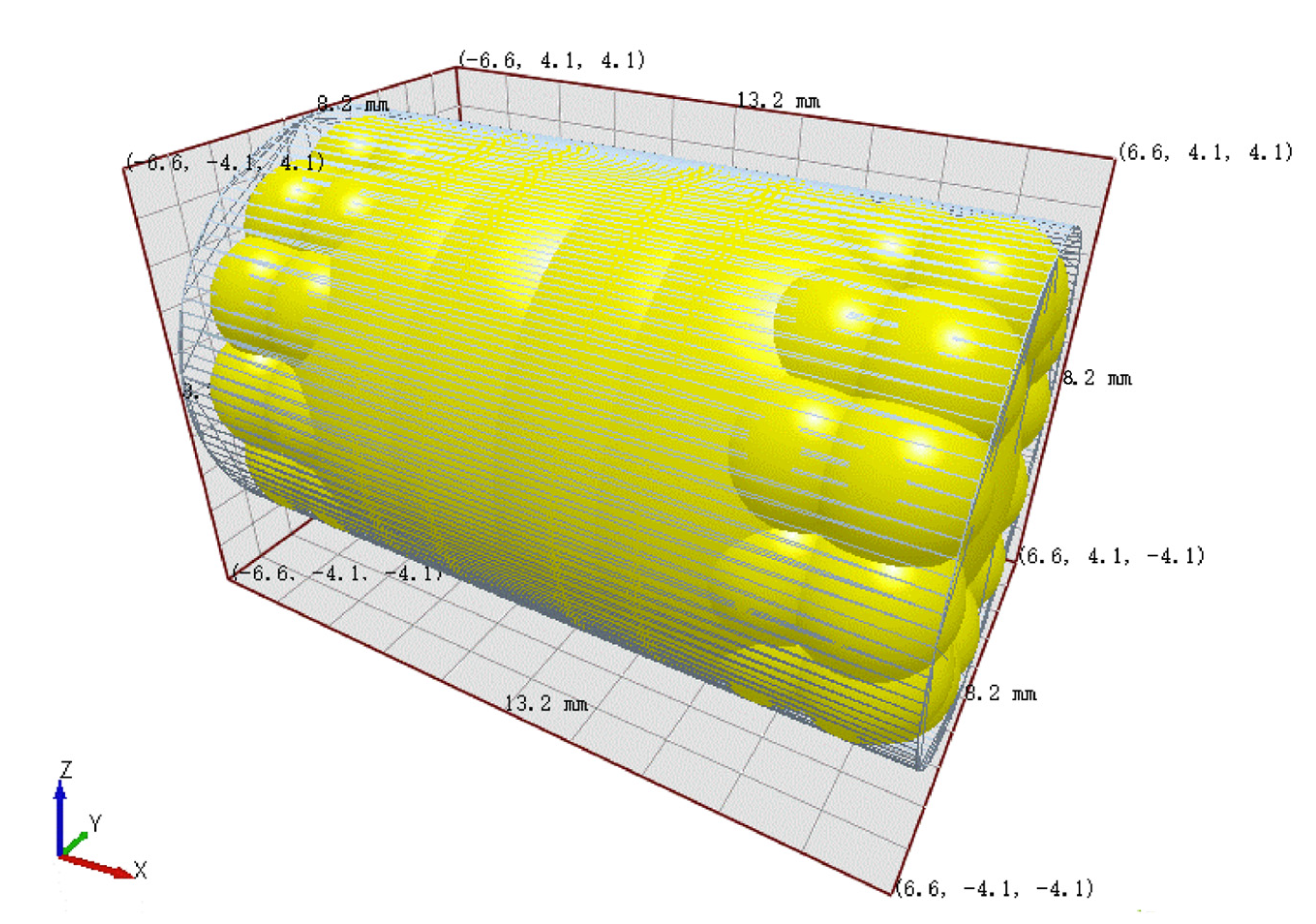
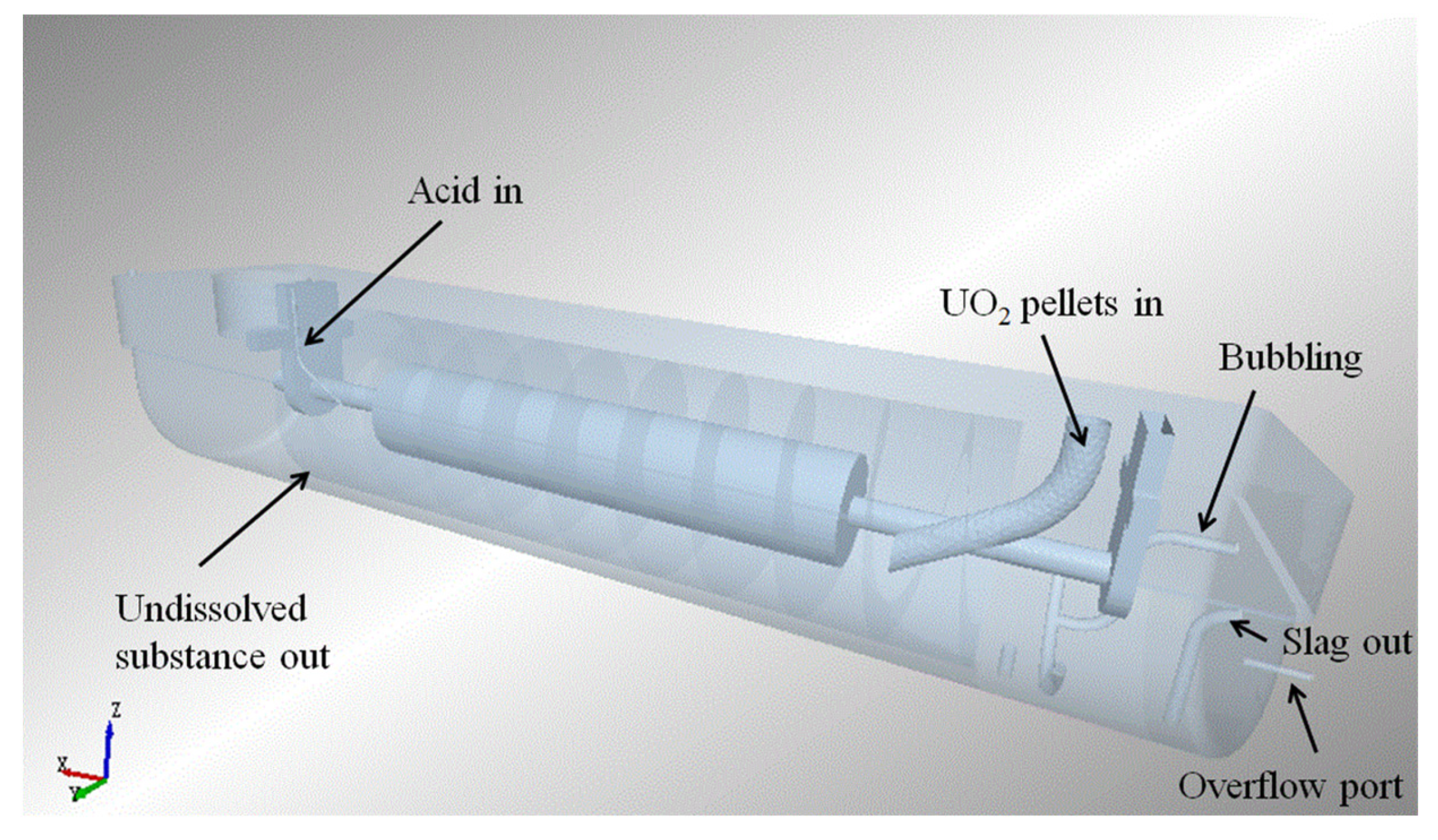

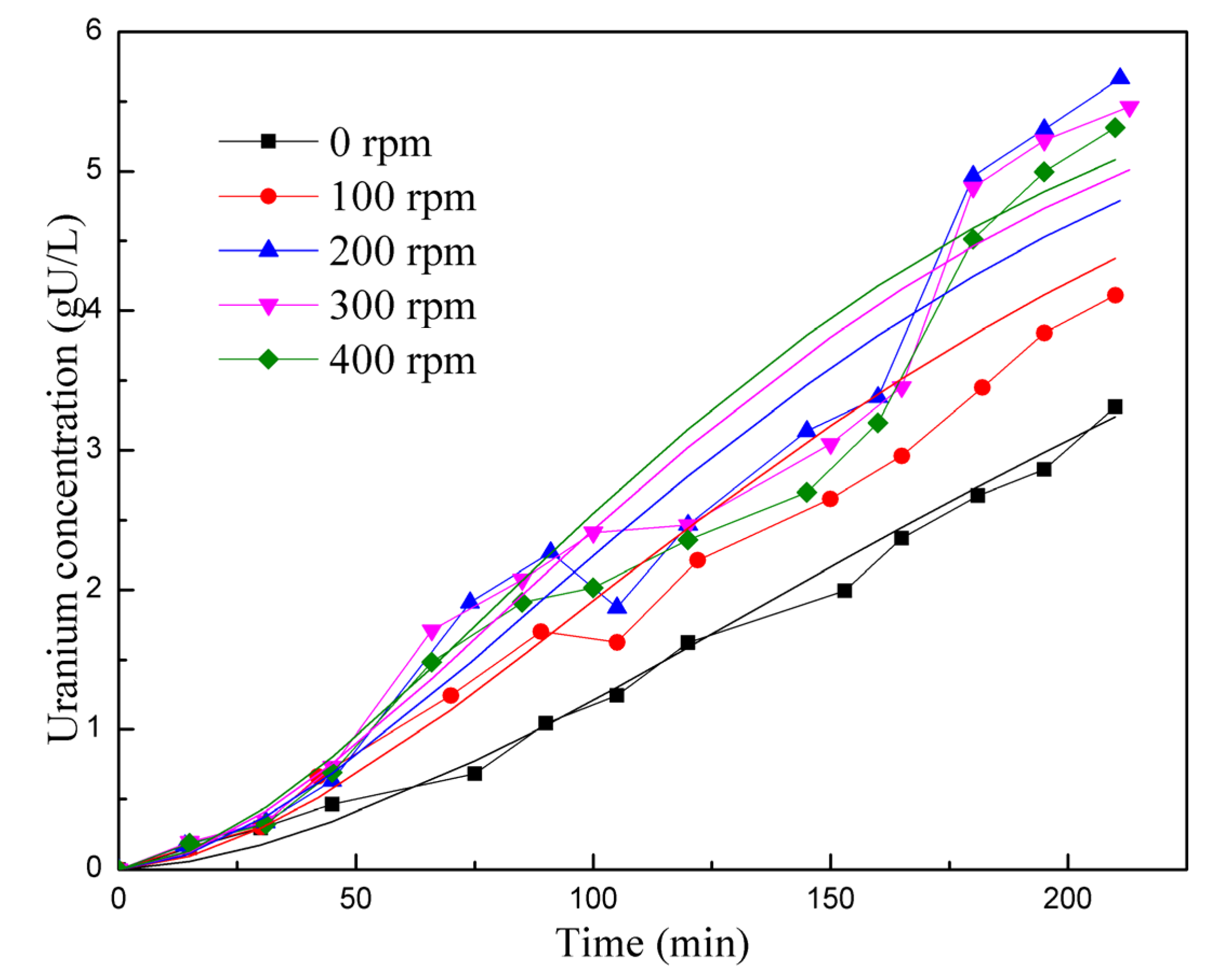
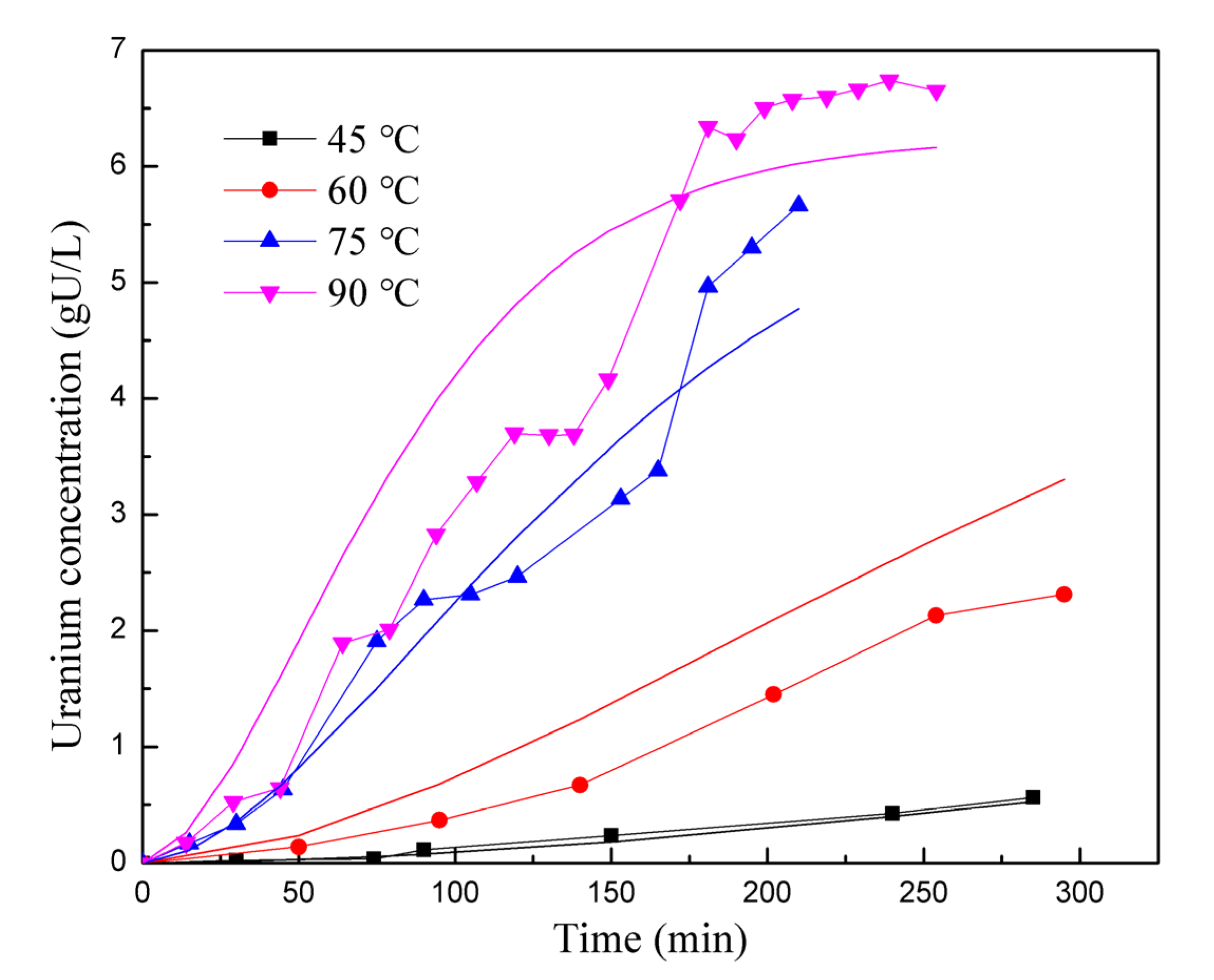
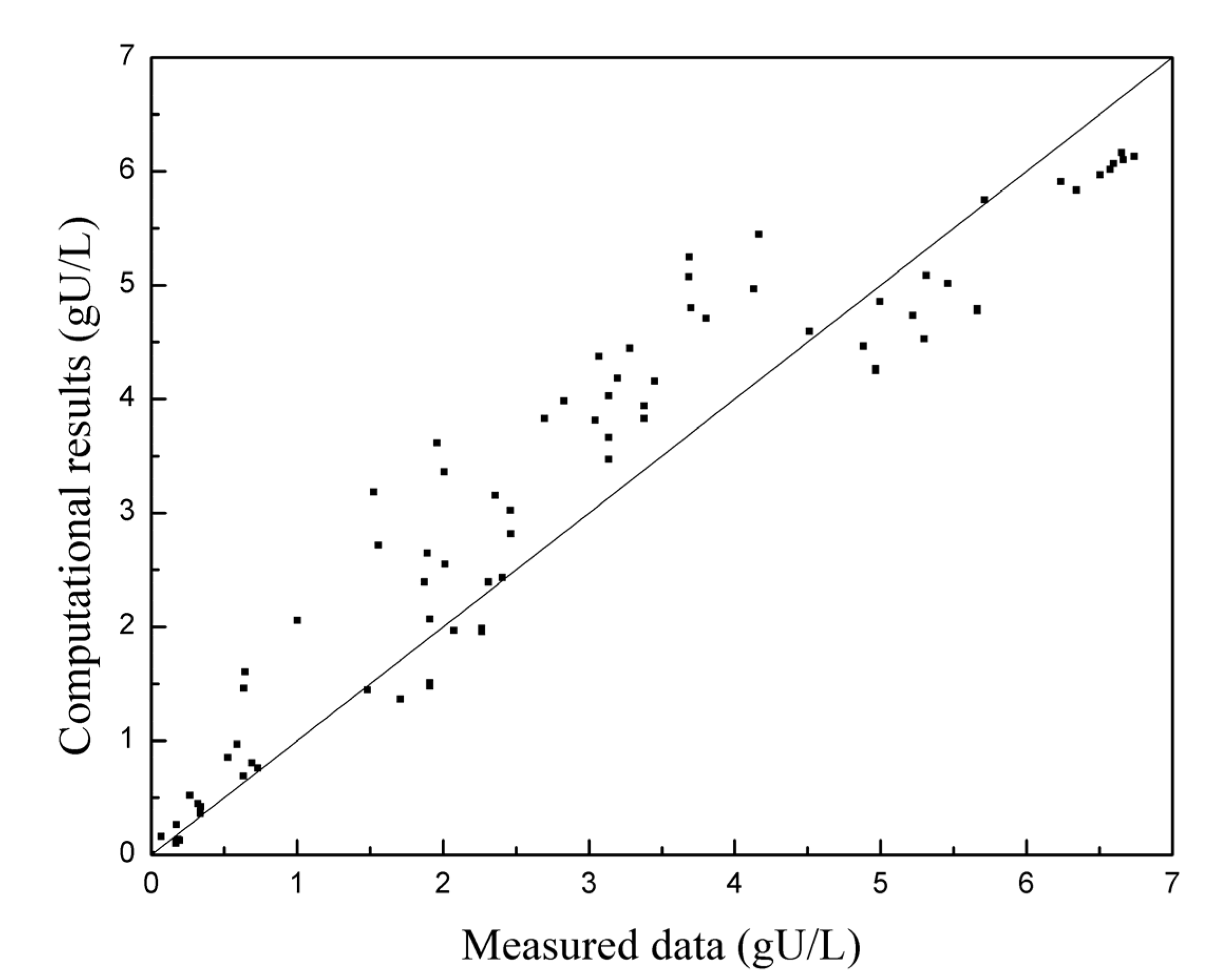
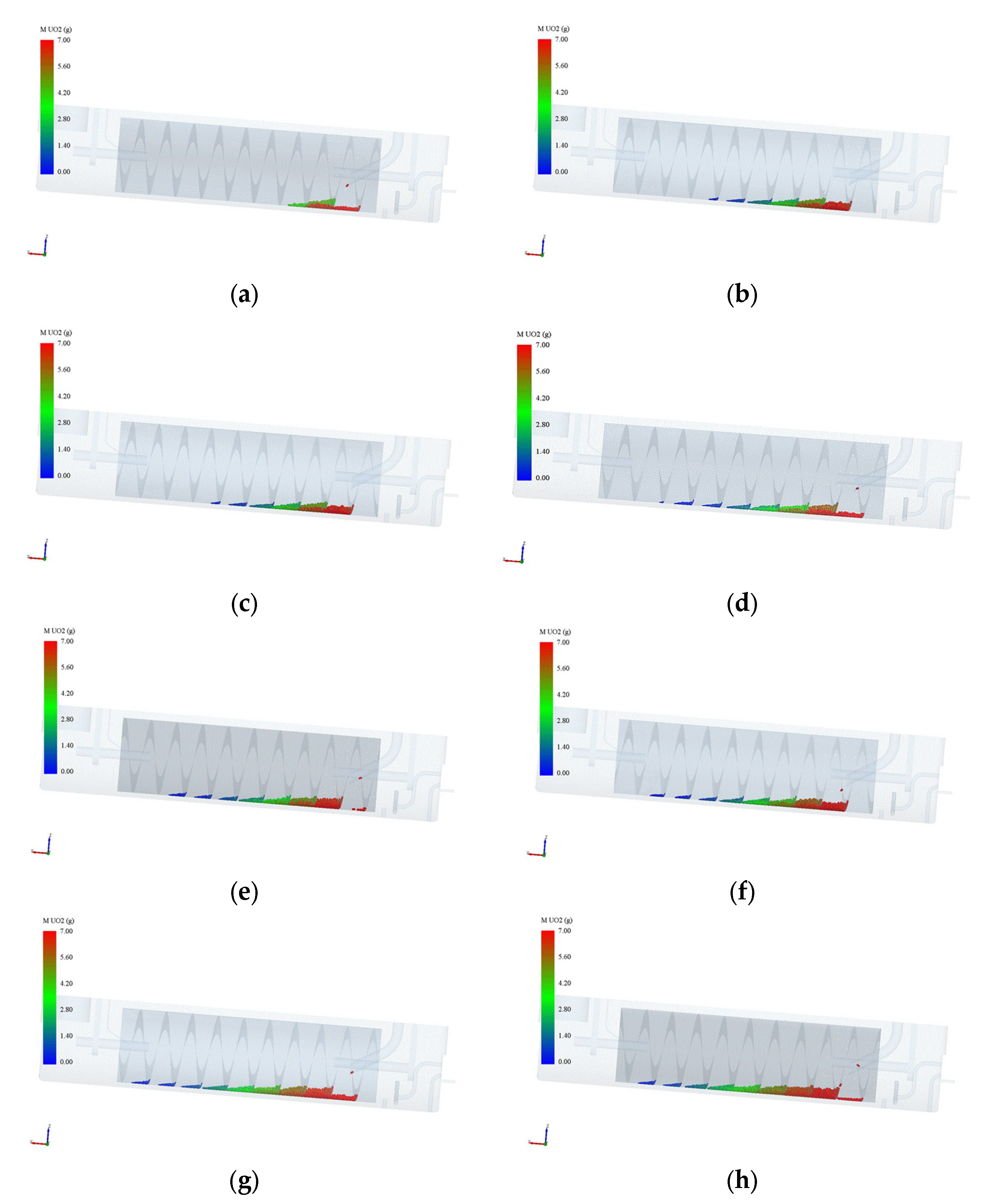

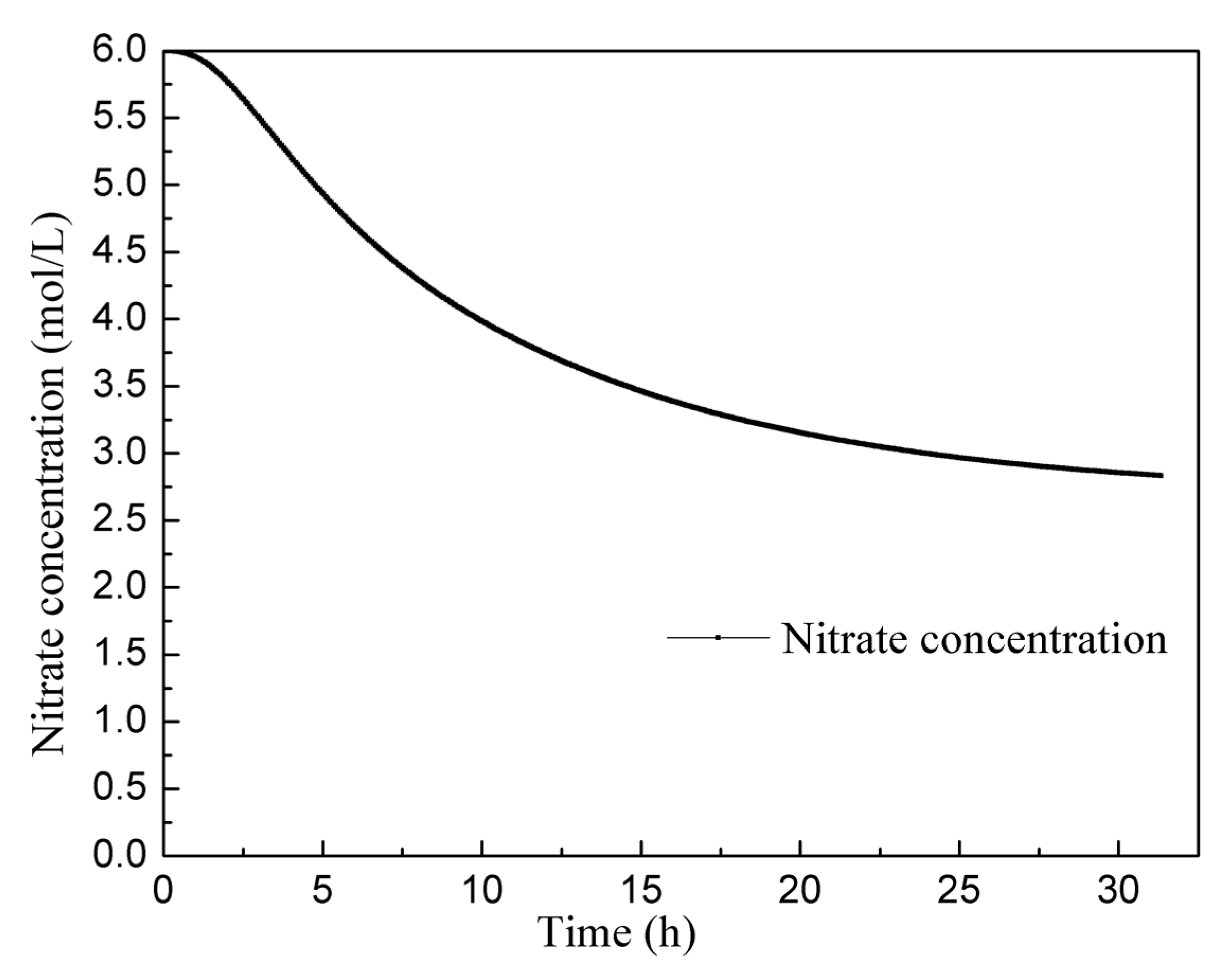
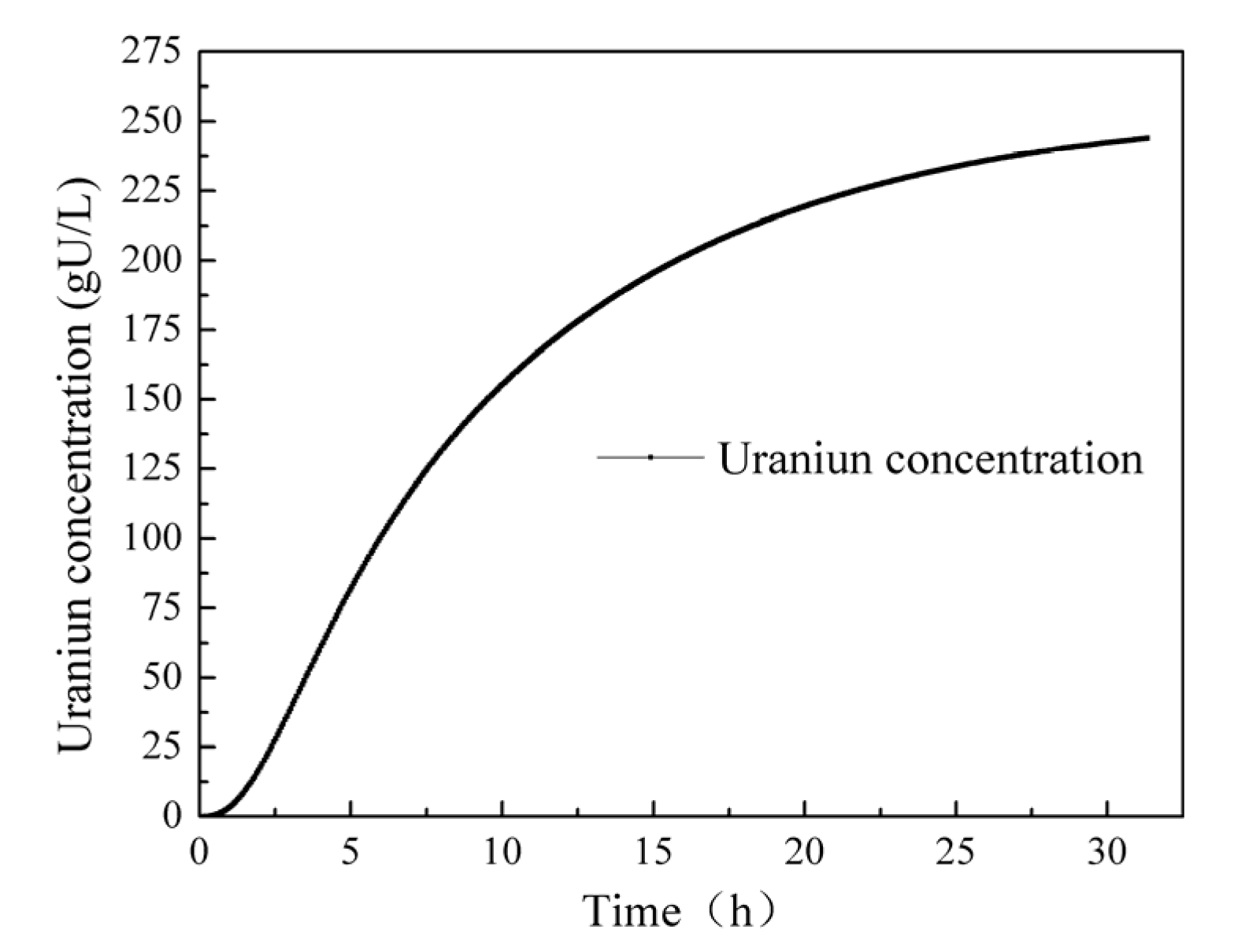
| Reaction Kinetic Model Parameter | Parameter Value |
|---|---|
| K1 | 2522.84 |
| K2 | 1.54 × 10−7 |
| E1 | −21,485.72 |
| E2 | −20,000.0 |
| E1,ref | 40,172.24 |
| E2,ref | −17,051.69 |
| γ | 2.3 |
| A1 | 2.69 |
| B1 | 0.76 |
| A2 | −18.16 |
| B2 | 8.84 |
| C2 | 9.32 |
| εmax | 24.34 |
| S1 | 0.12 |
| Variable | Value |
|---|---|
| Nitric acid feeding rate | 3.5 L/h (1.1257 g/s) |
| Concentration of acid | 6 mol/L |
| Density of UO2 | 10,350 kg/m3 |
| Fuel pellet charging rate | Five pellets every two minutes (each pellet is 7.08 g) |
| Drum rotating speed | 0.014 rpm |
| Operating pressure | 101.325 kPa |
| Overflow outlet pressure | 101.325 kPa |
| Variable | Value |
|---|---|
| Poisson’s ratio | 0.25 |
| Density | 10,350 kg/m3 |
| Shear modulus | 107 Pa |
| Coefficient of restitution | 0.1 |
| Coefficient of static friction | 0.1 |
| Coefficient of rolling friction | 0.1 |
Disclaimer/Publisher’s Note: The statements, opinions and data contained in all publications are solely those of the individual author(s) and contributor(s) and not of MDPI and/or the editor(s). MDPI and/or the editor(s) disclaim responsibility for any injury to people or property resulting from any ideas, methods, instructions or products referred to in the content. |
© 2023 by the authors. Licensee MDPI, Basel, Switzerland. This article is an open access article distributed under the terms and conditions of the Creative Commons Attribution (CC BY) license (https://creativecommons.org/licenses/by/4.0/).
Share and Cite
Li, T.; Liu, F.; Zhou, J.; Zuo, C.; Yan, T.; Zheng, W. Establishment and Verification of the Kinetics Model of Uranium Continuous Dissolution by Using Discrete Element Method. Processes 2023, 11, 2343. https://doi.org/10.3390/pr11082343
Li T, Liu F, Zhou J, Zuo C, Yan T, Zheng W. Establishment and Verification of the Kinetics Model of Uranium Continuous Dissolution by Using Discrete Element Method. Processes. 2023; 11(8):2343. https://doi.org/10.3390/pr11082343
Chicago/Turabian StyleLi, Tianchi, Fang Liu, Jia Zhou, Chen Zuo, Taihong Yan, and Weifang Zheng. 2023. "Establishment and Verification of the Kinetics Model of Uranium Continuous Dissolution by Using Discrete Element Method" Processes 11, no. 8: 2343. https://doi.org/10.3390/pr11082343






